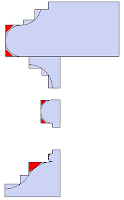I'm very partial to rabbet planes. They're easy to use and extremely versatile. Let this be a supplement to Larry Williams'
Making Traditional Side Escapement Planes. Refer to this video if you have questions regarding the tools used, flattening the bed, heat treating the iron, etc.
If you have questions regarding how to use the plane
check this link out.
The mortise for this plane is a little harder to make than side escapement planes since it is fully visible on both ends. There are more contact points the wedge must touch. Flattening the bed is also more tricky (at least for me).
After laying out the shape, saw the escapement and drill two holes to start the mortise.
Using
floats, I work on a single side of the mortise first. This thinner wedge should mate flush at the top and bottom with no high spots in between. I use dial calipers to ensure that the mortise is vertical by comparing the top to the bottom.
Fit the wedge. Since you know that one side of the mortise is already correct, all of the work here will be done on the opposite side. (Note: I follow this same process with side escapement planes. I work to completion on the blind side first and fit the wedge by exclusively working on the escapement side.)
I make the mortise and fit the wedge at this stage. Fitting the wedge to the front of the mortise now is much cleaner than if you were to start working on the escapement. I won't have to worry about blowout at the bottom.
Working from both sides towards the middle, I use a forstner bit to bore a 1" hole straight through.
Roughly cut out the escapement at the bottom of the mortise and top of the mouth. This allows the wedge, once fit to the mortise and iron, to make contact in the mortise the way that it ultimately will.
Cut the wear angle for the iron and fit the wedge to the iron.
Flatten the the bed.
I often get asked what tools I use for the escapement. I wish I had a great answer.
I carve it.
and sand it.
You can take it from here, right? If not, check out Larry's dvds.

























































